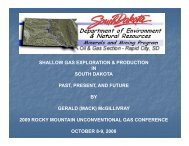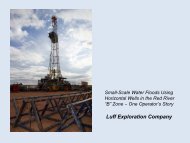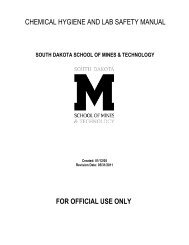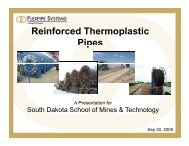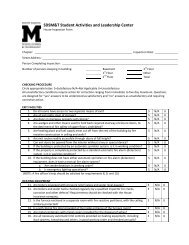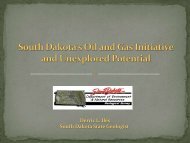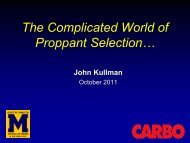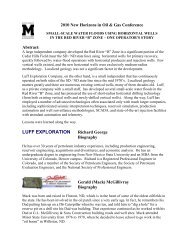SPE 119242 How to Use and Misuse Proppant Crush Tests – E i th ...
SPE 119242 How to Use and Misuse Proppant Crush Tests – E i th ...
SPE 119242 How to Use and Misuse Proppant Crush Tests – E i th ...
You also want an ePaper? Increase the reach of your titles
YUMPU automatically turns print PDFs into web optimized ePapers that Google loves.
<strong>SPE</strong> <strong>119242</strong><br />
<strong>How</strong> <strong>to</strong> <strong>Use</strong> <strong>and</strong> <strong>Misuse</strong><br />
<strong>Proppant</strong> <strong>Crush</strong> <strong>Tests</strong> <strong>–</strong><br />
EExposing i <strong>th</strong>e <strong>th</strong> Top T 10 My<strong>th</strong>s M <strong>th</strong><br />
John Kullman, CARBO Ceramics<br />
T. T. Palisch, M. Chapman, R. Duenckel, <strong>and</strong> S.<br />
Woolfolk Woolfolk, CARBO Ceramics Ceramics, Inc Inc.<br />
M. C. Vincent, Insight Consulting
Outline<br />
• Introduction/Motivation<br />
• <strong>Crush</strong> Test Procedure<br />
• MMy<strong>th</strong>s <strong>th</strong>s<br />
<strong>–</strong><strong>Misuse</strong>/misapplication pp<br />
• Summary
The Big Picture<br />
• Fracs must provide:<br />
<strong>–</strong> Reservoir contact (leng<strong>th</strong>, height) <strong>to</strong> contact <strong>and</strong><br />
collect oil <strong>and</strong> gas<br />
• Related <strong>to</strong> volume of proppant<br />
<strong>–</strong> Flow capacity <strong>to</strong> carry oil <strong>and</strong> gas <strong>to</strong> <strong>th</strong>e wellbore<br />
• Related <strong>to</strong> proppant permeability <strong>and</strong> frac wid<strong>th</strong> <strong>–</strong><br />
described as conductivity<br />
• O<strong>th</strong>er Important <strong>Proppant</strong> Characteristics<br />
<strong>–</strong> Durability<br />
<strong>–</strong> Temperature Resistance<br />
<strong>–</strong> Transportability<br />
<strong>–</strong> Fluid Compatibility<br />
<strong>–</strong> Flowback Control<br />
<strong>–</strong> Environmentally Benign
• GGas Well W ll<br />
<strong>–</strong> 7500 psi stress<br />
Question…<br />
<strong>–</strong> You can successfully place a 16/20 or 16/30<br />
sized proppant<br />
• Two choices of proppant<br />
<strong>–</strong> <strong>Proppant</strong> A <strong>–</strong> 16/20 Ceramic, 14% <strong>Crush</strong> (7.5k)<br />
<strong>–</strong> <strong>Proppant</strong> B <strong>–</strong> 16/30 Ceramic, 7.5% <strong>Crush</strong> (7.5k)<br />
<strong>–</strong> Which proppant would you choose?<br />
<strong>–</strong> What if I <strong>to</strong>ld you y <strong>th</strong>at <strong>th</strong>ey y had <strong>th</strong>e same MPD?<br />
<strong>–</strong> What would you be willing <strong>to</strong> pay for your choice?
Introduction/Motivation<br />
• API RP56 & 60 original <strong>–</strong> updated in ISO<br />
13503-2 (2006)<br />
<strong>–</strong> “improve quality…delivered proppants”<br />
<strong>–</strong> “enable…<strong>to</strong> compare physical properties”<br />
<strong>–</strong> OOriginal i i l iintent t t t<strong>to</strong> help h l qualify lif s<strong>and</strong> d sources<br />
• “<strong>Crush</strong> results” <strong>and</strong> proppant selection<br />
<strong>–</strong> “ “qualified lifi d engineering i i analysis….required l i i d ffor<br />
<strong>th</strong>eir application <strong>to</strong> a specific situation”<br />
<strong>–</strong> <strong>SPE</strong> 11634 <strong>–</strong> Conductivity comparisons cannot<br />
be made on <strong>th</strong>e basis of crush tests<br />
**Yet Yet many still choose <strong>th</strong>eir proppants based on<br />
crush results **
ISO 13503-2 <strong>Crush</strong> Test Procedure<br />
• P<strong>Proppant</strong> t is i pre-sieved i d t<strong>to</strong><br />
remove particles outside of<br />
stated mesh range.<br />
• DDry proppant t placed l d iin steel t l<br />
cell at ~4 lb/sq ft (s<strong>and</strong><br />
equivalent)<br />
• Room temperature<br />
• <strong>Proppant</strong> evenly distributed<br />
wi<strong>th</strong> level surface<br />
• LLoad d applied li d at t uniform if rate t<br />
• Constant stress maintained for<br />
two minutes<br />
• <strong>Proppant</strong> is sieved. The weight percent which falls<br />
below <strong>th</strong>e primary screen is reported.<br />
<strong>–</strong> For 16/20 proppant all material < 20 mesh is reported as “fines” fines<br />
<strong>–</strong> For 30/50 proppant all material < 50 mesh is reported as “fines”
ISO 13503-2 <strong>Crush</strong> Test Procedure<br />
Do <strong>th</strong>ese reflect realistic conditions?<br />
• <strong>Proppant</strong> is pre-sieved.<br />
• <strong>Proppant</strong> Loading <strong>–</strong> s<strong>and</strong>/RCS/LWC ~4 lb/ft2 ,<br />
IDC 4.8 lb/ft2 , Bauxite ~5.2 lb/ft2 • Smoo<strong>th</strong>, steel plates <strong>–</strong> embedment?<br />
• “Carefully y loaded”<br />
• Dry, room temperature<br />
• 2000 psi/min, psi/min relaxed after 2 minutes<br />
• Only <strong>th</strong>e particles smaller <strong>th</strong>an bot<strong>to</strong>m screen<br />
are considered “fines” fines or “crush” crush
Are <strong>th</strong>e results repeatable/reliable?<br />
<strong>Crush</strong> Cell Loading critical<br />
• “variance in crush results….associated wi<strong>th</strong><br />
me<strong>th</strong>od of loading…”<br />
• Significant efforts ongoing on ISO Committee<br />
<strong>and</strong> StimLab <strong>to</strong> alleviate variations in results<br />
<strong>–</strong> Loading technique <strong>th</strong>ought <strong>to</strong> be <strong>th</strong>e cause<br />
<strong>–</strong> Lab <strong>to</strong> lab, technician <strong>to</strong> technician, equipment <strong>to</strong><br />
equipment
Perrcent<br />
<strong>Crush</strong>h<br />
26<br />
24<br />
22<br />
20<br />
18<br />
16<br />
14<br />
12<br />
10<br />
8<br />
6<br />
4<br />
2<br />
0<br />
9.118<br />
10.663<br />
10.995<br />
Are <strong>th</strong>e results repeatable?<br />
16/30 Brown S<strong>and</strong> H<strong>and</strong> Loaded Weight Percent <strong>Crush</strong> at 4000psi<br />
25.221<br />
23.660<br />
24.229<br />
16.770<br />
14.660<br />
16.770<br />
24.552<br />
14.771<br />
17.886<br />
15.774<br />
17.552<br />
18.445<br />
9.220<br />
9.880<br />
10.110<br />
23.226<br />
23.229<br />
24.775<br />
6.004<br />
5.992<br />
6.442<br />
14.8% Avg<br />
8.440<br />
8.990<br />
8.660<br />
Test#1<br />
Test#2<br />
Test#3<br />
17.778<br />
19.888<br />
18.443<br />
9.110<br />
9.550<br />
9.110<br />
1 2 3 4 5 6 7 8 9 10 11<br />
Lab Number ISO Subcommittee Results
Perrcent<br />
<strong>Crush</strong>h<br />
18<br />
16<br />
14<br />
12<br />
10<br />
8<br />
6<br />
4<br />
2<br />
0<br />
9. .79<br />
9. .40<br />
9. .26<br />
Are <strong>th</strong>e results repeatable?<br />
16/30 Brown S<strong>and</strong> Mechanical Loaded Weight Percent <strong>Crush</strong> at<br />
4000psi<br />
Test#1<br />
8. .96<br />
16. .66<br />
11. .41<br />
12. .00<br />
12. .00<br />
12. .80<br />
10. .32<br />
10. .89<br />
10. .79<br />
10.<br />
9.<br />
9.<br />
.53<br />
.07<br />
.85<br />
7. .80<br />
8. .40<br />
7. .76<br />
10. .49<br />
10. .22<br />
9. .94<br />
10.0% Avg<br />
No data<br />
reported<br />
8. .40<br />
8. .20<br />
8. .40<br />
7. .50<br />
7. .50<br />
9. .23<br />
Test#2<br />
Test#3<br />
10. .10<br />
10. .80<br />
10. .60<br />
1 2 3 4 5 6 7 8 9 10 11<br />
Lab Number ISO Subcommittee Results
Does Fracture Wid<strong>th</strong> Affect <strong>Crush</strong>?<br />
• Interior grains loaded “evenly”<br />
• Exterior grains g have fewer<br />
load points<br />
• <strong>Crush</strong> increases significantly<br />
as proppant loading<br />
decreases<br />
• For a 20/40 proppant, <strong>th</strong>ere are approximately<br />
24 layers of proppant in st<strong>and</strong>ard crush test. test<br />
<strong>–</strong> 8% are exterior grains<br />
1 lb/ft2 • 1 lb/ft i 6 l f 20/40 t<br />
2 is ~6 layers of 20/40 proppant<br />
<strong>–</strong> 33% are exterior grains
<strong>Crush</strong> Depends p Upon p Frac Wid<strong>th</strong>!<br />
<strong>Crush</strong><br />
Percent<br />
30<br />
25<br />
20<br />
15<br />
10<br />
5<br />
0 4 lb/sq ft 2 lb/sq ft 1 lb/sq ft 0.5 lb/sq ft 0.25 lb/sq ft<br />
Monolayer<br />
~ 0.2 lb/sq ft
% <strong>Crush</strong><br />
100%<br />
90%<br />
80%<br />
70%<br />
60%<br />
50%<br />
<strong>Crush</strong> vs # Layers<br />
<strong>Crush</strong> at 10,000 psi<br />
20/40 <strong>Proppant</strong>s<br />
40%<br />
1lb/ft 2<br />
1 lb/ft 2<br />
40% B it 1 lb/ft 2<br />
Bauxite<br />
ELWC<br />
30%<br />
20%<br />
10%<br />
0%<br />
1 lb/ft 2<br />
S<strong>and</strong> &<br />
RCS<br />
White S<strong>and</strong><br />
ELWC<br />
RCS<br />
BBauxite it Ceramic C i<br />
0 1 2 3 4 5 6 7 8 9 10<br />
# of Layers
% <strong>Crush</strong>h<br />
100%<br />
90%<br />
80%<br />
70%<br />
60%<br />
50%<br />
40%<br />
30%<br />
20%<br />
10%<br />
0%<br />
<strong>Crush</strong> vs # Layers<br />
<strong>Crush</strong> at 1000 psi<br />
All 20/40 <strong>Proppant</strong>s<br />
1 lb/ft 2<br />
Bauxite<br />
1 lb/ft 2<br />
ELWC<br />
White S<strong>and</strong><br />
RCS<br />
ELWC<br />
Bauxite Ceramic<br />
1 lb/ft 2<br />
S<strong>and</strong> &<br />
RCS<br />
0 1 2 3 4 5 6 7<br />
# of Layers<br />
Partial<br />
Monolayer
RANGE OF FRACTURE COMPLEXITY<br />
<strong>SPE</strong> 77441<br />
Simple p Fracture Complex p Fracture<br />
Very Complex Fracture Network<br />
Complex fracs are<br />
believed <strong>to</strong> provide less<br />
cumulative conductivity<br />
<strong>th</strong>an simple, simple wider<br />
fractures
16<br />
Vertical Complexity<br />
DDue TTo Joints J i t<br />
Physical evidence of<br />
fractures nearly<br />
always complex<br />
NEVADA TEST SITE<br />
HYDRAULIC FRACTURE<br />
MINEBACK
Uniform Packing<br />
Is <strong>th</strong>is ribbon laterally y<br />
extensive <strong>and</strong><br />
continuous for<br />
hundreds or<br />
<strong>th</strong>ous<strong>and</strong>s of feet?<br />
17<br />
Arrangement?<br />
Pinch out, proppant<br />
pillars, ill iirregular l<br />
distribution?
Are Large Particles weaker <strong>th</strong>an Small?<br />
Pounds P of Force F <strong>to</strong> CPF cru ush one pell let<br />
80.00<br />
70.00<br />
60.00<br />
50.00<br />
40.00<br />
30.00<br />
20 20.00 00<br />
10.00<br />
Si y = l 1488 1488.2x P 2 2ll - 18 18.714 t C 714 h<br />
R 2 y = 1488.2x - 18.714<br />
R = 0.7765<br />
2 y = 1488.2x - 18.714<br />
R = 0.7765<br />
2 Single Pellet <strong>Crush</strong><br />
= 0.7765<br />
18<br />
16<br />
20/40<br />
16/20<br />
12/18<br />
0.00<br />
14<br />
0.0000 0.0100<br />
12<br />
0.0200 0.0300 0.0400 0.0500 0.0600<br />
<strong>Proppant</strong> Size inches Courtesy Stim-Lab<br />
Percent<br />
<strong>Crush</strong><br />
10<br />
8<br />
6<br />
4<br />
2<br />
0<br />
NO!!<br />
30/50 LWC 20/40 LWC 16/20 LWC 12/18 LWC
For all proppant types, larger grains have<br />
greater individual streng<strong>th</strong> streng<strong>th</strong>.<br />
CPF<br />
160<br />
140<br />
120<br />
100<br />
80<br />
60<br />
40<br />
20<br />
0<br />
20/40<br />
12/18<br />
0 0.02 0.04 0.06 0.08 0.1 0.12<br />
<strong>Proppant</strong> pp Size, , inches<br />
Source: Stim-Lab Consortium, July 2001 1.8-16<br />
CarboLite<br />
Hi Hickory k<br />
Interprop<br />
CoSilica<br />
Jordan<br />
ResinPR
Ano<strong>th</strong>er Look at Single Grain Streng<strong>th</strong>s…<br />
CPF<br />
160<br />
140<br />
120<br />
100<br />
80<br />
60<br />
40<br />
20<br />
0<br />
20/40<br />
12/18<br />
0 0.02 0.04 0.06 0.08 0.1 0.12<br />
<strong>Proppant</strong> pp Size, , inches<br />
Source: Stim-Lab Consortium, July 2001 1.8-16<br />
CarboLite<br />
Hi Hickory k<br />
Interprop<br />
CoSilica<br />
Jordan<br />
ResinPR<br />
Note <strong>th</strong>at application of<br />
resin does not improve p<br />
grain streng<strong>th</strong>, but ra<strong>th</strong>er<br />
improves distribution of<br />
stress between grains<br />
<strong>and</strong> encapsulates fines.
So why does crush increase<br />
• Streng<strong>th</strong> in numbers?<br />
wi<strong>th</strong> i<strong>th</strong> llarge proppants? t ?
“There’s Streng<strong>th</strong> in Numbers”<br />
Smaller mesh sizes distribute <strong>th</strong>e load <strong>to</strong> across<br />
more particles compared <strong>to</strong> larger mesh sizes
<strong>Proppant</strong> Type<br />
• Natural quartz crystals (s<strong>and</strong>), manufactured ceramics, <strong>and</strong><br />
resin-coated proppants crush differently<br />
• S<strong>and</strong><br />
<strong>–</strong> QQuartz t crystals t l tend t dt <strong>to</strong> result lti in a greater t number b of ffi fine shards h d<br />
• Ceramics<br />
<strong>–</strong> Tend <strong>to</strong> cleave or part p in<strong>to</strong> relatively y few, , larger g ppieces<br />
• Resin Coated Products<br />
<strong>–</strong> Resin does not significantly change single grain streng<strong>th</strong>, but<br />
improves distribution of stress stress. If <strong>th</strong>e particles can be<br />
encapsulated, <strong>th</strong>ey will not be measured as “crush” regardless of<br />
whe<strong>th</strong>er <strong>th</strong>e substrate fails<br />
<strong>SPE</strong> 11634 - conductivity comparisons cannot be made on <strong>th</strong>e basis of<br />
crush tests.
Do all <strong>Proppant</strong>s Fail in <strong>th</strong>e Same Manner?<br />
Brown S<strong>and</strong><br />
at t6k 6k psi. i<br />
RCS at 8k psi.<br />
When <strong>th</strong>ey fail fail…<br />
<strong>–</strong> S<strong>and</strong>s shatter like a glass<br />
<strong>–</strong> CCeramics i cleave l lik like a bbrick i k<br />
<strong>–</strong> Resin Coated products<br />
“deform”; deform ; fines captured<br />
IDC at<br />
8k psi.
Do fines affect all proppants similarly?<br />
RRemember… b<br />
• All proppants do not fail in <strong>th</strong>e same manner<br />
<strong>–</strong> The fines generated by one proppant may look<br />
drastically different <strong>th</strong>an <strong>th</strong>ose generated by<br />
ano<strong>th</strong>er. <strong>th</strong><br />
• The packing arrangement for similarly sized<br />
proppants are not <strong>th</strong>e same for all types of<br />
proppants.<br />
<strong>–</strong> i.e. <strong>th</strong>e packing arrangement for a 20/40<br />
ceramic, 20/40 RCS <strong>and</strong> 20/40 S<strong>and</strong> will be<br />
diff different t even at t comparable bl stresses.<br />
t
ht Perceent<br />
in Siize<br />
Rangge<br />
Weig<br />
Post <strong>Crush</strong> Sieve Distribution<br />
100<br />
75<br />
50<br />
25<br />
0<br />
98<br />
After crushing 20/40<br />
EconoProp at 6000 psi<br />
St<strong>and</strong>ard API technique<br />
1.18 0.43 0.2 0.13 0.08 0<br />
-20/+40 -40/+50 -50/+70 -70/+100 -100/+200 -200/+325 Pan<br />
Source: CARBO Analyses Nov 1998
A Closer Look at <strong>th</strong>e <strong>Crush</strong>ed Fraction<br />
Percent P <strong>Crush</strong> C<br />
1.20<br />
1.00<br />
0.80<br />
0.60<br />
0.40<br />
0.20<br />
0.00<br />
1.18<br />
“2% fines” reported wi<strong>th</strong> st<strong>and</strong>ard<br />
testing could mean 2 cleaved grains<br />
per 100 (4 immobile pieces), or it could<br />
represent 400 mobile fragments in <strong>th</strong>e<br />
100-mesh range<br />
Immobile cleaved grains It makes a difference!<br />
0.43<br />
0.2<br />
Potentially mobile in 20/40 pack<br />
(<strong>SPE</strong> 24008)<br />
0.13<br />
0.08<br />
-40/+50 -50/+70 -70/+100 -100/+200 -200/+325 Pan<br />
Source: CARBO Analyses Nov 1998<br />
0
Fluid Effects<br />
• <strong>Crush</strong> testing is performed dry. What if <strong>th</strong>e proppant<br />
is saturated?<br />
Percentt<br />
<strong>Crush</strong><br />
7<br />
6<br />
5<br />
4<br />
3<br />
2<br />
1<br />
0<br />
Modified <strong>Crush</strong> Test Results<br />
EEconoProp P at t 6000 psi i<br />
Dry API Moisten in cell<br />
Moistenincell Moisten in cell Moisten wi<strong>th</strong><br />
Moisten wi<strong>th</strong><br />
wi<strong>th</strong> water wi<strong>th</strong> min. oil water, <strong>th</strong>en min. oil, <strong>th</strong>en<br />
add <strong>to</strong> cell add <strong>to</strong> cell<br />
Source: CARBO Tech Brochure 3/4/96
Is one set of Test Conditions superior <strong>to</strong> ano<strong>th</strong>er?<br />
Cruush<br />
%<br />
35<br />
30<br />
25<br />
20<br />
15<br />
10<br />
5<br />
0<br />
St<strong>and</strong>ard<br />
Loadingg<br />
Dry, y, wet, , hot, , room temperature, p , water or oil…<br />
is one me<strong>th</strong>od more realistic <strong>th</strong>an ano<strong>th</strong>er?<br />
Load by<br />
h<strong>and</strong> <strong>and</strong><br />
rotate<br />
pis<strong>to</strong>n<br />
Load by<br />
h<strong>and</strong> <strong>and</strong><br />
do not<br />
rotate<br />
pis<strong>to</strong>n<br />
6k <strong>Crush</strong> @ 2#/ft2<br />
S<strong>and</strong><br />
ELWC<br />
RCS<br />
St<strong>and</strong>ard St<strong>and</strong>ard St<strong>and</strong>ard Wet wi<strong>th</strong> Wet wi<strong>th</strong> St<strong>and</strong>ard St<strong>and</strong>ard<br />
<strong>th</strong>en tapp<br />
<strong>th</strong>en wet <strong>th</strong>en wet water <strong>th</strong>en mineral oil but heat <strong>to</strong> but heat <strong>to</strong><br />
cell wi<strong>th</strong> water wi<strong>th</strong> load in<strong>to</strong> <strong>th</strong>en load 200F dry 200F wet<br />
mineral oil cell in<strong>to</strong> cell
Can <strong>Crush</strong> results be Correlated <strong>to</strong> Conductivity?<br />
More Realistic Conditions in a Conductivity Test<br />
What’s <strong>th</strong>e Difference?<br />
• <strong>Proppant</strong>s pp evaluated as received<br />
• <strong>Tests</strong> equivalent mass loading, <strong>and</strong> 2 lb/ft2<br />
• Utilizes S<strong>and</strong>s<strong>to</strong>ne shims<br />
• Flow water <strong>th</strong>rough pack<br />
• Elevated temperatures (150° (150 or 250° 250 F)<br />
• Stress held for at least 50 hours
Disassembled API <strong>Proppant</strong> Cell<br />
<strong>Proppant</strong> Bed<br />
Ports for Measuring<br />
Differential Pressure<br />
Temperature Port<br />
S<strong>and</strong>s<strong>to</strong>ne Cores<br />
Flow Through<br />
<strong>Proppant</strong> Bed
Long Term Conductivity Cells
Can <strong>Crush</strong> results be Correlated <strong>to</strong> Conductivity?<br />
<strong>Crush</strong> C %<br />
45<br />
40<br />
35<br />
30<br />
25<br />
20<br />
15<br />
10<br />
5<br />
0<br />
St<strong>and</strong>ard<br />
Loading<br />
The “crush” measured after a Conductivity test<br />
significantly higher <strong>th</strong>an <strong>Crush</strong> test.<br />
6k <strong>Crush</strong> Results vs <strong>Crush</strong> after Conductivity Testing at 6k psi<br />
Load by<br />
h<strong>and</strong> <strong>and</strong><br />
rotate<br />
pis<strong>to</strong>n<br />
Load by<br />
h<strong>and</strong> <strong>and</strong><br />
do not<br />
rotate<br />
pis<strong>to</strong>n<br />
St<strong>and</strong>ard St<strong>and</strong>ard St<strong>and</strong>ard<br />
<strong>th</strong>en tap <strong>th</strong>en wet <strong>th</strong>en wet<br />
cell wi<strong>th</strong> water wi<strong>th</strong><br />
mineral oil<br />
Wet wi<strong>th</strong> Wet wi<strong>th</strong><br />
water <strong>th</strong>en mineral oil<br />
load in<strong>to</strong> <strong>th</strong>en load<br />
cell in<strong>to</strong> cell<br />
S<strong>and</strong><br />
ELWC<br />
RCS<br />
St<strong>and</strong>ard St<strong>and</strong>ard<br />
but heat <strong>to</strong> but heat <strong>to</strong><br />
200F dry 200F wet<br />
All tests at 2 lb/ft 2 loading
Embedment<br />
More wid<strong>th</strong> retained,<br />
but lower perm
Spalling
Spalling
Example of Conductivity Loss<br />
100000<br />
10000<br />
1000<br />
100<br />
10<br />
CONDUCTIVITY VS. CLOSURE STRESS<br />
Stim -Lab Inc.<br />
P redkF02<br />
`<br />
YME=5E6psi<br />
YME=1E6psi<br />
YME=.5E6psi<br />
YME=.1E6psi<br />
0 2000 4000 6000 8000 10000 12000<br />
CLOSURE STRESS - PSI<br />
11.0lb/sqft 0lb/ ft 20/40B 20/40Badger150°F d 150°F 11.0lb/sqft 0lb/ ft 20/40B 20/40Badger150°F<br />
d 150°F<br />
1.0lb/sqft 20/40Badger150°F 1.0lb/sqft 20/40Badger150°F<br />
Source: Stim-Lab Consortium, Feb 2002 1.6-46
In <strong>th</strong>e real world:<br />
<strong>Proppant</strong> Durability<br />
- Fractures are subjected <strong>to</strong> high stresses<br />
(increasing) for extended periods of time<br />
- Stress levels fluctuate (cyclic stress) wi<strong>th</strong><br />
wellwork ll k <strong>and</strong> d changes h iin li line pressure<br />
Therefore:<br />
• All proppants appear <strong>to</strong> lose conductivity over<br />
ti time<br />
• Traditional resins do not appear <strong>to</strong> protect<br />
proppants p oppa s from o deg degradation. ada o<br />
• Many data suggest degradation is a mechanical<br />
failure, not chemical attack. 38
<strong>Proppant</strong> Durability<br />
• Traditional “long term” conductivity tests maintain<br />
stress on proppant for 50 hours<br />
<strong>–</strong> It is known <strong>th</strong>at proppants continue <strong>to</strong> degrade beyond<br />
50 hours, but <strong>th</strong>is was a practical compromise between<br />
labora<strong>to</strong>ry expense <strong>and</strong> accuracy accuracy. Fig 4, 4 <strong>SPE</strong> 16415<br />
Longer test captures a portion of<br />
<strong>th</strong>e time-dependent decline. We<br />
know degradation continues<br />
beyond y <strong>th</strong>is, , but modern “50 hour”<br />
tests include correction for initial<br />
repacking/etc.<br />
This phenomenon occurs even<br />
wi<strong>th</strong> silica saturation<br />
Reference: <strong>SPE</strong> 16415 Nor<strong>to</strong>n <strong>and</strong> Stim-Lab<br />
Conducctivity<br />
(mdd-ft)<br />
1000<br />
100<br />
20/40 Jordan s<strong>and</strong>,<br />
8000 psi<br />
0 25 50 75 100<br />
Hours at Constant Stress
% Original O Conductiv<br />
C vity<br />
Extended duration tests:<br />
1984<br />
(75 & 250F)<br />
API “short term” cell: Metal plates, continuous flowing 2% KCl,<br />
Non Non-silica silica saturated<br />
100<br />
80<br />
60<br />
40<br />
20<br />
0<br />
Fig 19, <strong>SPE</strong> 12616 between metal plates<br />
20/40 S<strong>and</strong> at 75F<br />
10/20 S<strong>and</strong> at 250F<br />
0 30 60 90 120 150 180 210 240 270 300<br />
Days at Constant Stress, 5000 psi<br />
Reference: <strong>SPE</strong> 12616 by Montgomery, Steanson, Schlumberger<br />
40
Permmeability<br />
Ratio R<br />
Published extended duration tests:<br />
1986<br />
93C (200F)<br />
All non-corrodible surfaces, prop in<br />
Teflon tube, continuous flowing 2% KCl<br />
1<br />
0.8<br />
0.6<br />
0.4<br />
0.2<br />
0<br />
Fig 4, <strong>SPE</strong> 14133<br />
CarboPROP at 10,000 psi (69 MPa)<br />
CarboLITE at 10,000 psi (69 MPa)<br />
S<strong>and</strong> at 5000 psi (35 MPa)<br />
0 15 30 45 60 75<br />
Days at Constant Stress<br />
Connductivity<br />
(mmd-ft)<br />
1986<br />
(300F)<br />
Teflon tube, continuous flowing 2% KCl,<br />
Non-silica saturated<br />
10000<br />
1000<br />
100<br />
<strong>SPE</strong> Drilling, April 1986, page 5<br />
Interprop<br />
Proflow<br />
RCS<br />
Ottawa S<strong>and</strong><br />
0 10 20 30 40 50<br />
Days at Constant Stress, 8500 psi<br />
References: <strong>SPE</strong> 14133 by CARBO, <strong>SPE</strong> Drilling article by Nor<strong>to</strong>n-Alcoa <strong>Proppant</strong>s <strong>and</strong> TerraTek Research<br />
41
Temperature Correction for White S<strong>and</strong><br />
Connductivity<br />
Correction C from f 150 deeg<br />
F, fac<strong>to</strong>rr<br />
1<br />
0.8<br />
0.6<br />
0.4<br />
0.2<br />
0<br />
150 deg F<br />
200 degF<br />
250 deg F<br />
300 deg F<br />
350 deg F<br />
At 6500 psi <strong>and</strong> 250F, 20/40 White S<strong>and</strong> loses<br />
40% of f it its conductivity d ti it compared d <strong>to</strong> t 150F. 150F<br />
20/40 Premium White S<strong>and</strong><br />
0 1000 2000 3000 4000 5000 6000 7000 8000 9000 10000<br />
Stress, psi StimLab PredictK
Cyclic Loading of <strong>Proppant</strong> Packs<br />
• All proppants appear <strong>to</strong> be damaged by<br />
continued stress cycling<br />
Connductivity<br />
(mmd-ft)<br />
5,000<br />
4,000<br />
3,000<br />
2,000<br />
1,000<br />
-<br />
Effect of Stress Cycling on <strong>Proppant</strong>s<br />
Three cycles, 6000 <strong>to</strong> 1000 psi<br />
CARBO Tech Rpt 99-062<br />
50 hrs at 6000 psi<br />
3 cycles, 6000 <strong>to</strong> 1000<br />
23% loss<br />
32% loss<br />
Source: CARBO Tech Rpt 99-062<br />
15% loss<br />
RCS #1 RCS #2 EconoProp<br />
<strong>Proppant</strong> Type (all 20/40)
Condductivity<br />
(md-ft) (<br />
10,000<br />
9,000<br />
88,000 000<br />
7,000<br />
66,000 000<br />
5,000<br />
4,000<br />
3,000<br />
2,000<br />
1,000<br />
-<br />
Effect of Stress Cycling on <strong>Proppant</strong> Conductivity<br />
(Stim-Lab July 2000 data)<br />
St Stress (psi) ( i)<br />
LWC<br />
RCS<br />
Ceramic loses 26%, 26%<br />
RCS loses 35% due <strong>to</strong> 25 cycles<br />
0 100 200 300 400<br />
Hours
Perccent<br />
Crrush<br />
(wt% ( smmaller<br />
<strong>th</strong>an t 400<br />
mesh)<br />
30<br />
25<br />
20<br />
15<br />
10<br />
5<br />
CARBO Tech Rpt 99-062<br />
-<br />
Effect of Stress Cycling<br />
on <strong>Proppant</strong> <strong>Crush</strong> (6000 psi)<br />
1.37 1.52<br />
10.44<br />
Single <strong>Crush</strong> at 6000 psi<br />
Triple Cycle Dry <strong>Crush</strong><br />
Triple Cycle <strong>Crush</strong> in Long Term Cell<br />
3333.83 3.33<br />
15.79<br />
302 3.02<br />
1.92<br />
8.47<br />
RCS #1 RCS #2 EconoProp<br />
<strong>Proppant</strong> Type (all 20/40)
Options <strong>to</strong> reduce crush:<br />
Action <strong>Crush</strong> Conductivity<br />
Rename 16/20 <strong>to</strong> 16/30<br />
⇓ ~50% No change<br />
Add 30 mesh material <strong>to</strong> 16/20 <strong>and</strong> rename <strong>to</strong> 16/30<br />
⇓ ~60% ⇓ ~30%<br />
Reduce average proppant size or produce broader distribution<br />
⇓ ⇓<br />
Sticky additive <strong>to</strong> agglomerate fines<br />
⇓ ~100% ⇓<br />
Pre-cured or curable resins<br />
⇓ often ⇓ at low stress,<br />
⇑ at high g stress<br />
Include deformable “cushioning” agents<br />
⇓ ⇓
The Correct Way <strong>to</strong> Test <strong>Proppant</strong><br />
• Remember, proppant must achieve two goals:<br />
<strong>–</strong> Reservoir contact (proppant (p pp volume) )<br />
<strong>–</strong> Ability <strong>to</strong> conduct hydrocarbons wi<strong>th</strong> minimal pressure loss<br />
• These characteristics can be directly measured wi<strong>th</strong><br />
a conductivity test<br />
<strong>–</strong> <strong>Proppant</strong> confined between s<strong>and</strong>s<strong>to</strong>ne core<br />
<strong>–</strong> Realistic temperatures<br />
<strong>–</strong> Flowing brine, oil, <strong>and</strong>/or gas<br />
<strong>–</strong> 50 hour duration (or longer)<br />
<strong>–</strong> Cyclic stress, embedment, fines migration, non-Darcy <strong>and</strong><br />
o<strong>th</strong>er issues can be investigated g in specialized p tests<br />
<strong>–</strong> Directly measures parameters of interest [frac wid<strong>th</strong> <strong>and</strong><br />
flow capacity]
<strong>SPE</strong> <strong>119242</strong><br />
<strong>How</strong> <strong>to</strong> <strong>Use</strong> <strong>and</strong> <strong>Misuse</strong><br />
<strong>Proppant</strong> <strong>Crush</strong> <strong>Tests</strong> <strong>–</strong><br />
Exposing <strong>th</strong>e Top 10 My<strong>th</strong>s<br />
Questions?
Darcy’s Darcy s Law vs vs. Forchheimer Equation<br />
• Δ P/L = μ v /k / k<br />
<strong>–</strong> Pressure drop is proportional <strong>to</strong> fluid<br />
velocity l it<br />
<strong>–</strong> Applicable only at low flowrates<br />
• Δ P/L = μ v / k + β ρv 2<br />
<strong>–</strong> Pressure drop is proportional <strong>to</strong> square of<br />
fluid velocity<br />
<strong>–</strong> Applicable at realistic fracture flowrates
DDoes FFracture t Wid<strong>th</strong> Affect Aff t <strong>Crush</strong>? C h?<br />
• <strong>Crush</strong> increases significantly in narrow<br />
fractures<br />
Interior grains are loaded<br />
“evenly” evenly on 6 sides<br />
Exterior grains are not<br />
stressed uniformly
Long g Term Conductivity y Test<br />
Procedure<br />
• Load 63 g (equivalent <strong>to</strong> 2 lbs/sq ft) of proppant in<br />
each cell.<br />
• Install cells in <strong>th</strong>e press.<br />
• Purge 2% KCl solution wi<strong>th</strong> oxygen-free nitrogen.<br />
• Apply a vacuum for 45 minutes <strong>to</strong> remove air in<br />
cells.<br />
• Flow 2% KCl solution <strong>th</strong>rough heated silica s<strong>and</strong>,<br />
<strong>and</strong> d cells. ll<br />
• Ramp <strong>to</strong> an initial stress of 1000 psi <strong>and</strong> <strong>to</strong> a 500<br />
psi fluid pressure.<br />
• After checking equipment is working properly, heat<br />
cells <strong>to</strong> 250ºF.
Long Term Conductivity Test<br />
Procedure<br />
• Increase stress <strong>to</strong> 2,000 psi.<br />
• Flow fluid at rates of 33, 4 <strong>and</strong> 6 ml/min ml/min.<br />
Measure Δ p 30 minutes after each step<br />
change in flow rate.<br />
• Measure frac wid<strong>th</strong> <strong>and</strong> temperature. Maintain<br />
stress for 50 hr.<br />
• Increase stress in 22,000 000 psi increments for 50<br />
hours each.<br />
• Continue measuring Δ p at 3, 4 <strong>and</strong> 6 ml/min of<br />
fluid flow, frac wid<strong>th</strong> <strong>and</strong> temperature until<br />
12,000 psi stress is reached.
AB A Better tt Test T tt <strong>to</strong> Select S l tP <strong>Proppant</strong> t<br />
• Long term conductivity testing<br />
• Direct measurement of flow capacity of<br />
proppant pack<br />
• Can account for:<br />
<strong>–</strong> Embedment<br />
<strong>–</strong> Temperature<br />
<strong>–</strong> Fluid Effects<br />
<strong>–</strong> Fines Migration g ( (wi<strong>th</strong> appropriate pp p flowrates) )
54<br />
Chudnovsky, Univ of Ill, Chicago<br />
Is complexity<br />
solely attributed<br />
<strong>to</strong> “rock rock fabric”? fabric ?<br />
Unconsolidated 200 mesh s<strong>and</strong>, 35 lb XLG,<br />
Flow � <strong>SPE</strong> 63233<br />
Many o<strong>th</strong>er examples! [TerraTek, Baker, Weijers, CSM FAST consortium]
Frac Wid<strong>th</strong> <strong>–</strong> wi<strong>th</strong> CrossLinked Gel<br />
Diffuse slurry<br />
Modest concentration<br />
w f<br />
TSO + high concentration<br />
We don’t envision <strong>th</strong>ick<br />
filtercakes in very tight rock,<br />
but it doesn’t take much <strong>to</strong><br />
damage a narrow frac!<br />
Diffuse slurry<br />
Low concentration<br />
2 ppa [240 kg/m3 pp [ g ] s<strong>and</strong> slurry y is<br />
about 1 part solids <strong>to</strong> 7 parts liquid.<br />
Final frac wid<strong>th</strong> could be ~1/7 <strong>th</strong> <strong>th</strong>e<br />
pumping wid<strong>th</strong>!<br />
Navigation menu



